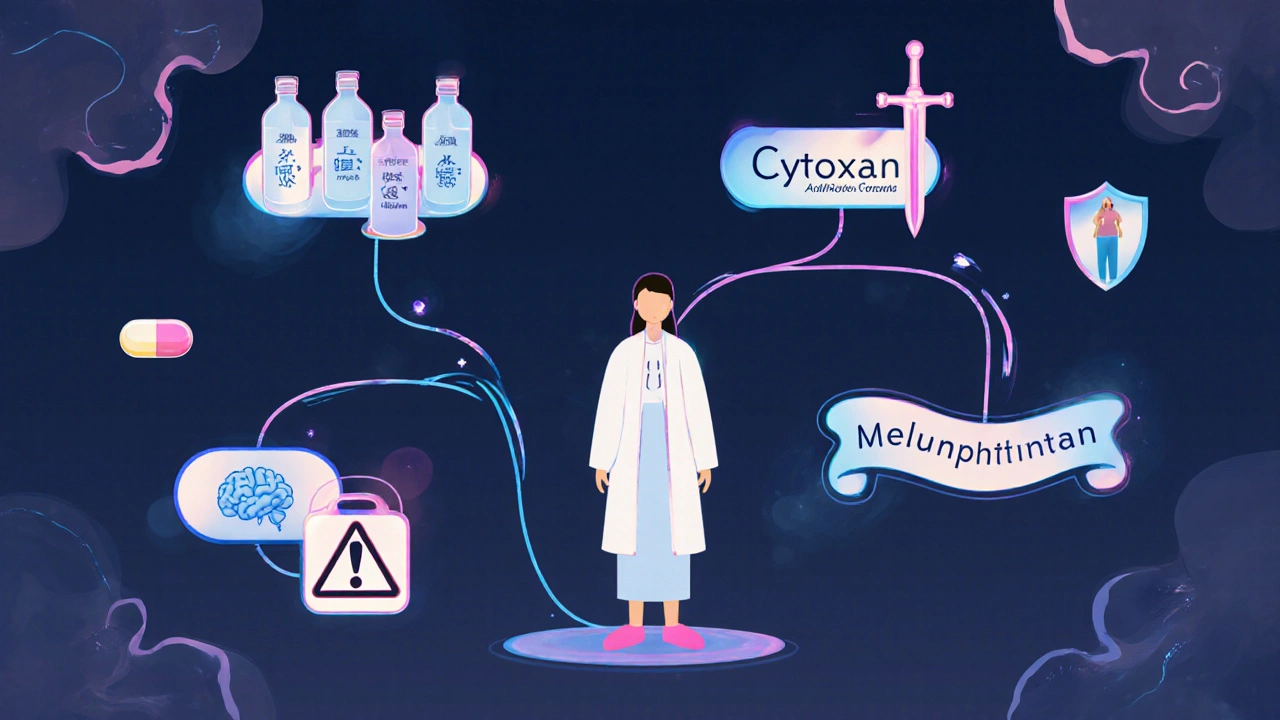Chemotherapy Drug Selector
Select Your Scenario
How This Works
This tool helps identify the most appropriate chemotherapy agent based on:
- Patient's specific cancer indication
- Age and comorbidities
- Organ function (renal/liver)
- History of treatment-related toxicity
Recommended Chemotherapy Agent
Why This Drug Was Selected
When a doctor picks a chemotherapy agent, the choice often feels like a high‑stakes game of chess: each move matters for tumor control, side‑effects, and patient quality of life. Cytoxan-the brand name for cyclophosphamide-has been a go‑to alkylating agent for decades, but a growing list of alternatives now vies for the same clinical niches. This guide breaks down what Cytoxan does, how its peers stack up, and which factors should tip the scale in real‑world practice.
What Is Cytoxan (Cyclophosphamide)?
Cytoxan is a nitrogen mustard alkylating agent that interferes with DNA replication by cross‑linking the strands, ultimately triggering cell death. First approved by the FDA in 1959, it remains a workhorse for a wide range of malignancies, including breast cancer, non‑Hodgkin lymphoma, leukemia, and certain solid tumors.
The drug is administered orally or intravenously, with dosing tailored to the disease protocol. Typical regimens range from 500 mg/m² every 4 weeks for breast cancer to high‑dose cycles of 1,200 mg/m² for conditioning before stem‑cell transplant.
Key pharmacokinetic facts:
- Absorbed quickly when taken orally; bioavailability ≈ 70 %.
- Metabolized in the liver by CYP2B6 into active metabolites (phosphoramide mustard, acrolein).
- Renally excreted; dose adjustments needed in renal impairment.
Common adverse effects include myelosuppression, nausea, alopecia, and hemorrhagic cystitis (caused by acrolein). Hydration and mesna prophylaxis are standard to protect the bladder.
Major Alternatives to Cytoxan
While Cytoxan’s breadth of use is impressive, several drugs offer similar mechanisms or complementary profiles. Below are the most frequently considered alternatives.
Ifosfamide
Ifosfamide is an alkylating agent closely related to cyclophosphamide, sharing the same nitrogen‑mustard core but differing in its activation pathway. It’s often chosen for sarcomas, testicular cancer, and high‑grade gliomas.
Key differences: ifosfamide requires activation by CYP3A4, produces a neurotoxic metabolite (chloroacetaldehyde), and carries a higher risk of encephalopathy. Like Cytoxan, mesna is used to prevent hemorrhagic cystitis.
Melphalan
Melphalan is another nitrogen‑mustard alkylator, primarily used in multiple myeloma and ovarian cancer. It’s administered orally or intravenously and is a staple in high‑dose conditioning regimens before autologous stem‑cell transplant.
Melphalan’s toxicity profile leans toward profound myelosuppression and mucositis, with less bladder irritation compared to cyclophosphamide.
Chlorambucil
Chlorambucil is an oral alkylating agent historically used for chronic lymphocytic leukemia (CLL) and low‑grade lymphomas. Its mechanism also involves DNA cross‑linking but with a lower potency than cyclophosphamide.
Because it’s less aggressive, chlorambucil is favored when long‑term treatment with minimal cytopenia is needed, though it has a slower onset of action.
Busulfan
Busulfan is an alkylating agent primarily used in chronic myeloid leukemia (CML) and as part of conditioning regimens for bone‑marrow transplant. Administered orally or intravenously, busulfan’s main toxicity is hepatic veno‑occlusive disease (VOD), making liver function a critical monitoring point.
Its dosing is highly individualized because of narrow therapeutic windows; therapeutic drug monitoring (TDM) is standard practice.

How Do These Drugs Compare? (Efficacy, Toxicity, Administration)
To help clinicians weigh options, the table below lines up the most pertinent attributes.
| Drug | Primary Indications | Route & Dosing Frequency | Major Toxicities | Unique Advantages |
|---|---|---|---|---|
| Cytoxan (Cyclophosphamide) | Breast, NHL, ALL, ovarian, some sarcomas | IV or PO; 500‑1,200 mg/m² every 3-4 weeks | Myelosuppression, hemorrhagic cystitis, alopecia | Broad spectrum, well‑studied dosing schedules |
| Ifosfamide | Sarcoma, testicular cancer, glioma | IV; 1,200‑1,800 mg/m² over 3 days | Neurotoxicity, cystitis, myelosuppression | Higher activity against soft‑tissue sarcoma |
| Melphalan | Multiple myeloma, ovarian cancer | IV; 140‑200 mg/m² single dose or 0.25‑0.5 mg/kg PO daily | Severe myelosuppression, mucositis | Preferred for high‑dose transplant conditioning |
| Chlorambucil | CLL, low‑grade lymphomas | PO; 0.1‑0.2 mg/kg daily | Moderate myelosuppression, long‑term leukemogenic risk | Gentle, suitable for elderly or frail patients |
| Busulfan | CML, transplant conditioning | IV; 0.8‑1.0 mg/kg every 6 hours (TDM‑guided) | Hepatic VOD, seizures, myelosuppression | Powerful myeloablative agent for stem‑cell transplant |
**Key takeaways from the table**:
- Cytoxan offers the widest indication list, making it a solid first‑line option for many regimens.
- Ifosfamide shines in sarcoma and CNS tumors but demands vigilant neuro‑monitoring.
- Melphalan’s dose‑intensity makes it unbeatable for transplant conditioning, yet its mucosal toxicity can be brutal.
- Chlorambucil provides a low‑intensity, oral‑only pathway-ideal for patients who can’t tolerate aggressive cytopenia.
- Busulfan’s narrow therapeutic index requires drug‑level testing, but it remains a cornerstone for CML and high‑dose transplant.
Clinical Decision Points: When to Choose Cytoxan vs. an Alternative
Every oncology case is a mix of disease biology, patient comorbidities, and treatment goals. Below are common scenarios and the drug that typically fits best.
- Node‑positive breast cancer requiring dose‑dense AC (Adriamycin/Cytoxan) schedule: Cytoxan is standard because its synergy with anthracyclines is well‑documented.
- High‑grade soft‑tissue sarcoma after surgery: Ifosfamide (often combined with doxorubicin) outperforms cyclophosphamide in response rates.
- Multiple myeloma patient heading for autologous stem‑cell rescue: High‑dose melphalan is favored over Cytoxan for more potent myeloablation.
- Elderly CLL patient with limited performance status: Oral chlorambucil provides disease control with minimal hospitalization.
- Patient undergoing allogeneic transplant for CML: Busulfan (with cyclophosphamide in some protocols) offers superior eradication of residual disease, but pure busulfan‑based regimens limit cyclophosphamide exposure.
Beyond disease‑specific guidelines, consider these universal filters:
- Renal function: Both cyclophosphamide and ifosfamide need dose reductions in creatinine clearance < 30 mL/min.
- Liver health: Busulfan’s hepatic VOD risk rises sharply with elevated bilirubin; melphalan also requires hepatic monitoring.
- Prior bladder toxicity: If a patient has a history of hemorrhagic cystitis, prefer melphalan or chlorambucil (which lack acrolein‑driven bladder injury).
- Neuro‑cognitive status: Avoid ifosfamide in patients with pre‑existing encephalopathy.

Practical Checklist for Prescribing
Keep this quick reference handy when you’re writing the order.
- Confirm indication matches the drug’s strongest evidence base.
- Check baseline labs: CBC, renal panel, liver panel, urinalysis.
- Hydration plan: at least 2 L/m²/day for cyclophosphamide/ifosfamide.
- Mesna dosing schedule (if indicated): 20 % of cyclophosphamide dose IV 15 min before, then at 4 h and 8 h.
- Schedule therapeutic drug monitoring for busulfan (target AUC 900‑1500 µM·min).
- Document consent discussion covering fertility risk, secondary malignancy potential, and organ‑specific toxicities.
Future Directions and Emerging Alternatives
While the classic alkylators still dominate many regimens, newer agents are reshaping the landscape.
Targeted therapies such as PARP inhibitors (olaparib) show synergy with cyclophosphamide in BRCA‑mutated breast cancer, potentially allowing lower cyclophosphamide doses. Immunotherapy combinations (e.g., pembrolizumab with low‑dose cyclophosphamide) aim to modulate the tumor microenvironment without severe myelosuppression.
Clinical trials are also exploring pro‑drug formulations of ifosfamide that release the active metabolite more selectively, hoping to cut down on neurotoxicity.
For now, the tried‑and‑true alkylators remain indispensable, but staying aware of trial data helps you anticipate when a newer option might replace an older workhorse.
Is cyclophosphamide still used as a first‑line treatment for breast cancer?
Yes. In the classic AC (Adriamycin‑Cyclophosphamide) regimen, cyclophosphamide is given every 3 weeks alongside doxorubicin and remains a cornerstone of early‑stage and HER2‑negative breast cancer protocols.
How does the toxicity of ifosfamide compare to cyclophosphamide?
Ifosfamide shares the bladder‑toxicity risk but adds a higher incidence of neurotoxicity (encephalopathy) and may cause more severe nausea. Both require mesna, but ifosfamide often needs closer neurologic monitoring.
When would chlorambucil be preferred over cyclophosphamide?
Chlorambucil is chosen for chronic lymphocytic leukemia or low‑grade lymphoma in older or frail patients where the goal is disease control with minimal cytopenia. Its oral-only route also improves quality of life compared to IV cyclophosphamide.
Can cyclophosphamide cause long‑term secondary cancers?
All alkylating agents carry a modest risk of therapy‑related leukemia or myelodysplastic syndrome years after treatment. The risk is dose‑dependent; high cumulative doses of cyclophosphamide increase the odds, so lifelong monitoring is advised.
What monitoring is required for busulfan therapy?
Therapeutic drug monitoring (TDM) is mandatory. Blood samples are taken after the first dose to calculate the area under the curve (AUC) and adjust subsequent doses to stay within the 900‑1500 µM·min target, minimizing the risk of hepatic VOD and seizures.

Melody Barton
October 25, 2025 AT 19:06Cytoxan is a solid workhorse, but remember to keep patients hydrated and use mesna to protect the bladder. It’s a good idea to tailor the dose to kidney function and always check blood counts before each cycle. This helps keep side‑effects manageable and patients feeling better throughout treatment.
Justin Scherer
November 7, 2025 AT 08:20When you compare cyclophosphamide to ifosfamide, the major difference is the activation pathway and neuro‑toxicity risk. Ifosfamide needs CYP3A4 and can cause encephalopathy, so patients with prior brain issues should avoid it. Otherwise, the dosing schedules are pretty similar, and both require mesna for bladder protection.
Cheyanne Moxley
November 18, 2025 AT 22:06Honestly, it’s absurd that doctors still prescribe a drug that can cause hemorrhagic cystitis without proper counseling. Patients deserve full transparency about the long‑term secondary cancer risk, and many clinicians just brush it off as ‘standard practice.’ This kind of laziness is unacceptable.
eko lennon
November 30, 2025 AT 11:53Stepping into the world of alkylating agents feels like walking onto a stage where every actor has a hidden agenda, and cyclophosphamide is none other than the seasoned veteran who has seen more battles than most of us could imagine.
Its history dates back to the late 1950s, a period when chemotherapy was still in its infancy and doctors were eager to find a drug that could actually make a dent in aggressive cancers.
Since then, Cytoxan has been given everything from breast cancer to lymphoma, and its versatility has made it the go‑to choice in countless protocols.
But the story doesn’t end there; the drug’s mechanism of cross‑linking DNA is a double‑edged sword that spares the tumor while also wreaking havoc on healthy marrow and the bladder lining.
That is why mesna and aggressive hydration are not optional extras but essential safety nets that protect patients from the nasty side‑effects that would otherwise turn treatment into a nightmare.
On the other hand, you have its cousins like ifosfamide, which brings a whole new set of complications, including neurotoxicity that can leave patients confused and disoriented.
Melphalan steps into the limelight when you need a powerful myeloablative agent for stem‑cell transplant, yet its mucositis can be so severe that patients sometimes can’t eat for weeks.
Chlorambucil, by contrast, wears a softer coat, making it suitable for elderly CLL patients who simply cannot tolerate the aggressive cytopenias that cyclophosphamide brings.
Busulfan demands meticulous drug‑level monitoring, because a slight overshoot can trigger hepatic veno‑occlusive disease, a condition no one wants to see on a lab report.
When a physician decides which drug to write on the order, they must weigh tumor biology, organ function, and the patient’s personal goals like quality of life and fertility preservation.
For example, a patient with marginal renal function will need a reduced cyclophosphamide dose, whereas someone with a history of seizures might be steered away from busulfan.
Furthermore, the presence of concurrent therapies, such as anthracyclines, can amplify both efficacy and toxicity, creating a delicate balancing act.
The future holds promise with PARP inhibitors that may allow lower doses of cyclophosphamide, potentially sparing patients from some of the harsh side‑effects.
Clinical trials are already exploring low‑dose cyclophosphamide combined with immunotherapy to modulate the tumor microenvironment without crushing the immune system.
All these nuances underline why no single drug can claim the throne universally; each case requires its own tailored regimen.
In the end, the art of oncology is as much about understanding these subtle differences as it is about the science, and that is what makes our work both challenging and rewarding.
Sunita Basnet
December 12, 2025 AT 01:40Synergy achieved with cyclophosphamide in HER2‑negative pathways leverages DNA cross‑linking kinetics and maximizes tumoricidal index during dose‑dense AC protocols
Optimized infusion rates and prophylactic mesna administration enhance therapeutic window while minimizing urothelial toxicity
Integration with PARP inhibition modules offers a promising combinatorial approach for BRCA‑mutated cohorts
Pamela Clark
December 23, 2025 AT 15:26Oh great, another endless table of side‑effects that nobody reads. As if we needed more reasons to avoid cyclophosphamide. But sure, keep prescribing the same old workhorse and hope for miracles.